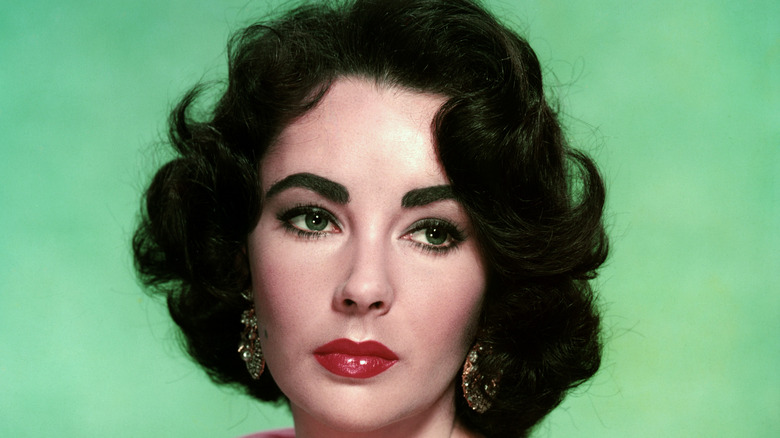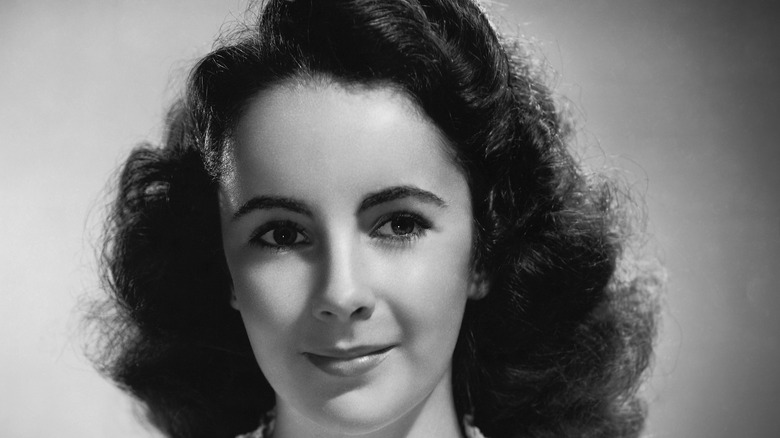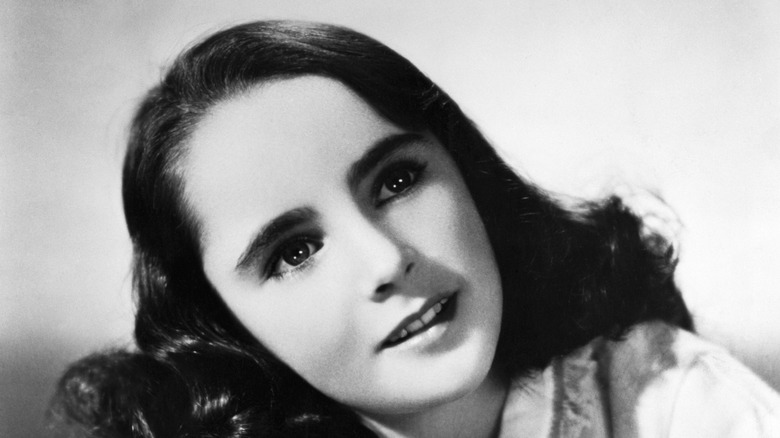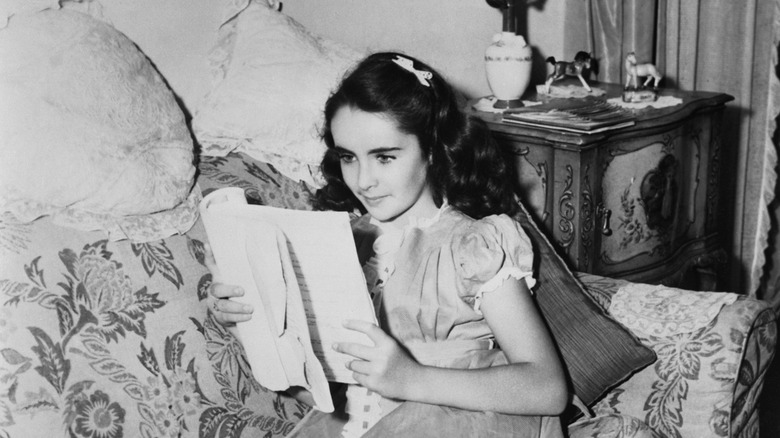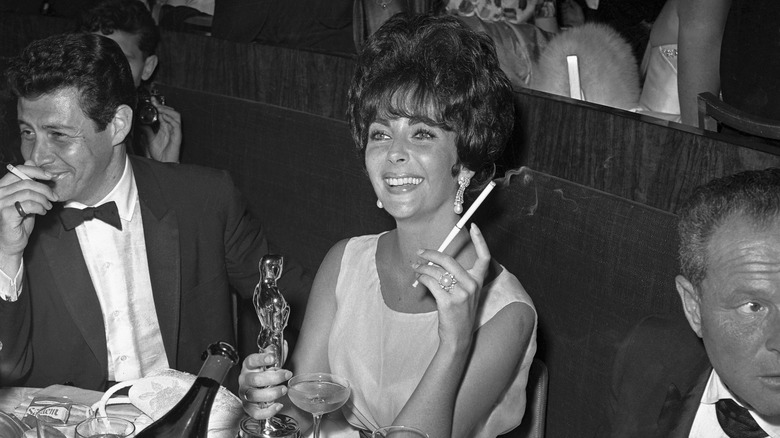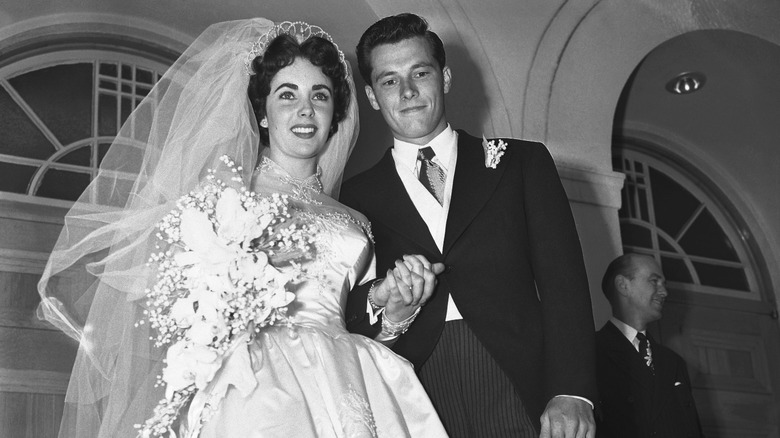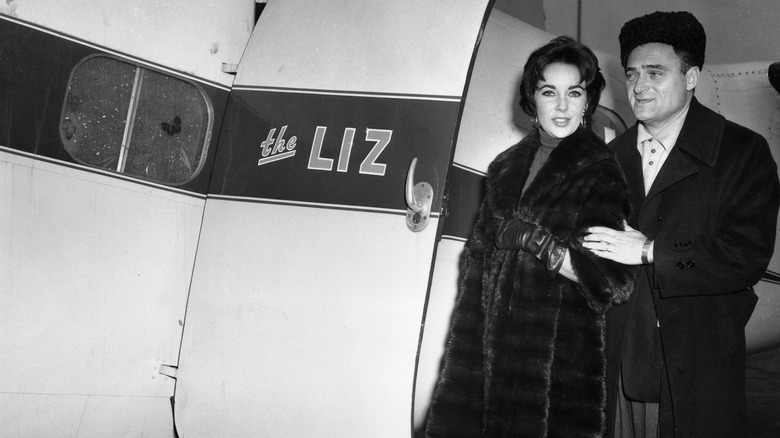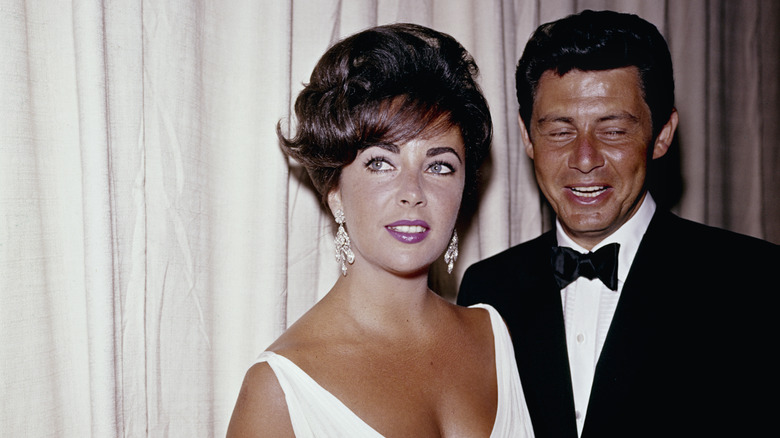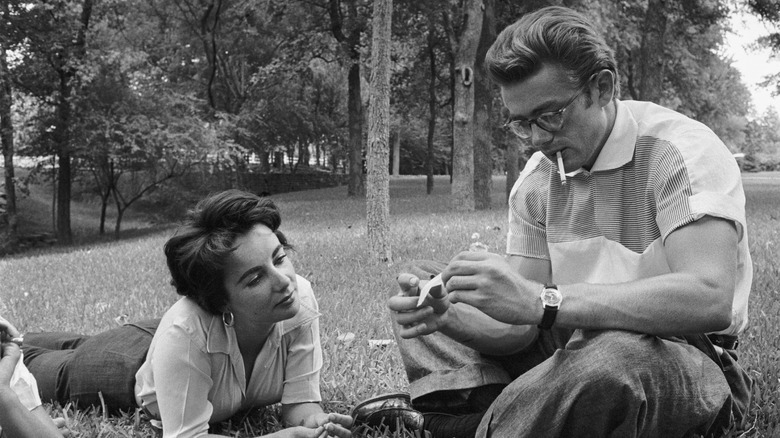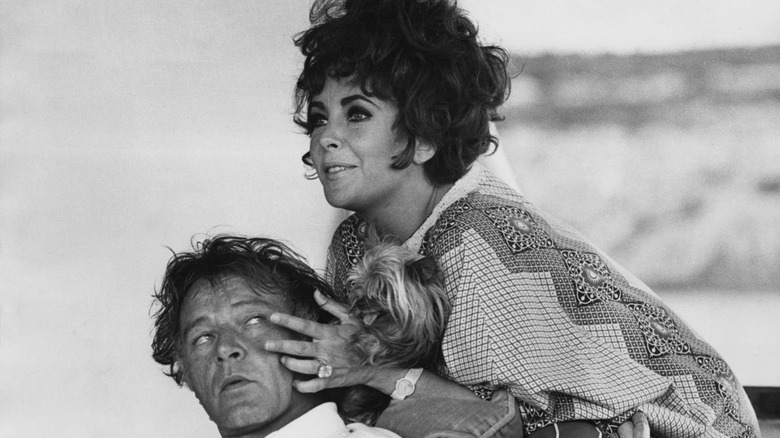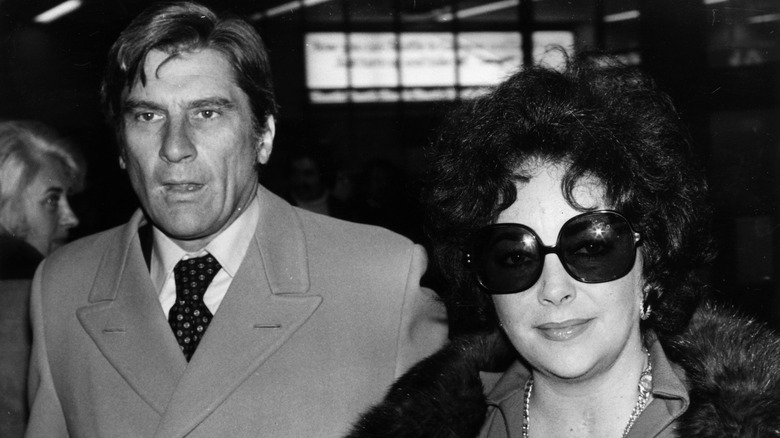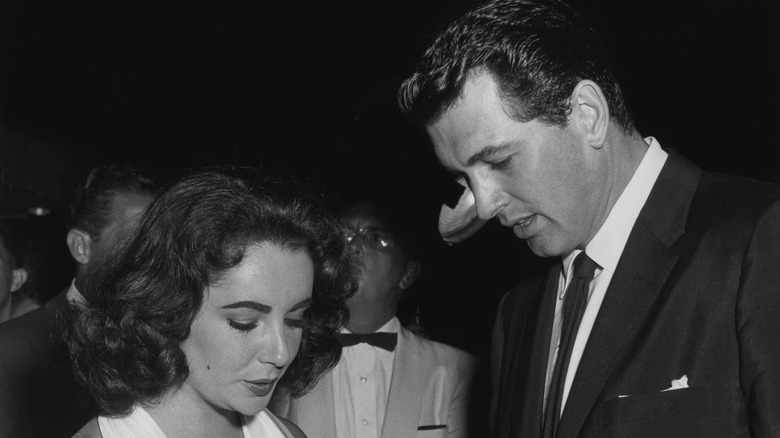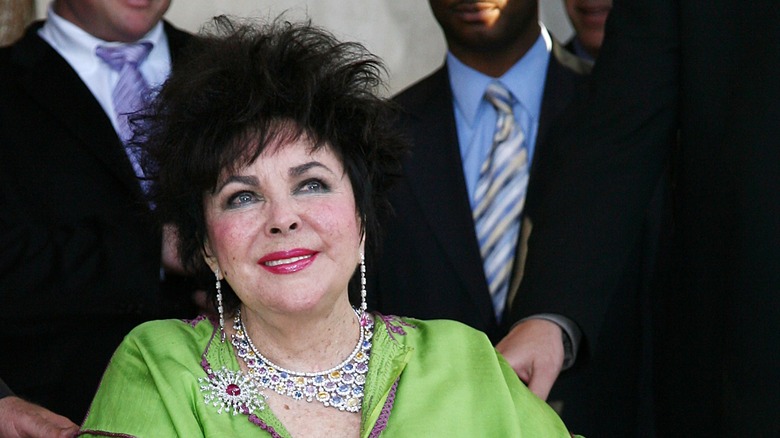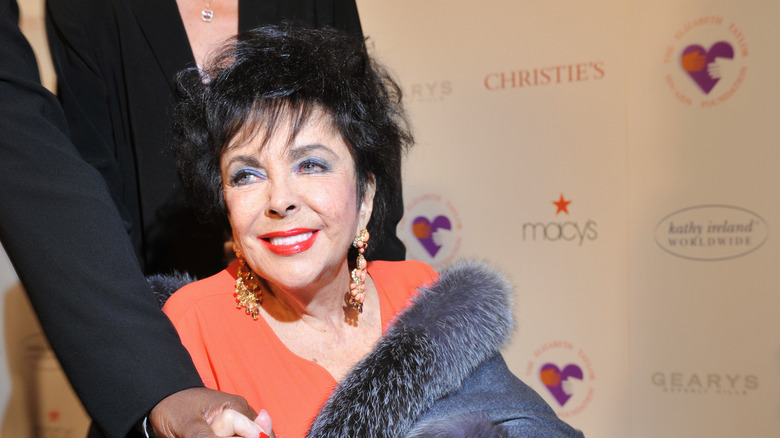Tragic Things About Elizabeth Taylor's Life
Elizabeth Taylor was one of the world's biggest movie stars in the 1960s and is remembered for her groundbreaking performances in films such as "Who's Afraid of Virginia Woolf," "Cat on a Hot Tin Roof," "Cleopatra," and more. Not only was she widely recognized for her acting talent, but she was also noted for her striking violet-toned eyes with rare double-set lashes, her slew of tumultuous marriages, her lucrative perfume and jewelry lines, and her lavish, jet-setting lifestyle.
However, behind all the glitz and glamor in the public eye, there was much hardship and chaos in Taylor's personal life. "My very first memory is of pain," Taylor told Us Weekly in 2010, a few months before her passing. But what exactly had she gone through, from her childhood fame to her death in 2011? Here are some tragic details about Dame Elizabeth Taylor's life that you might not have known about.
Her father was physically abusive
Born in London to Kansas-native parents, Elizabeth Taylor moved with her family to The United States when she was eight years old. Her father, Francies Lenn Taylor, was an art dealer, and her mother, Sarah Viola Warmbrodt, was an actress who inspired her daughter's love for film. By 1944, Taylor gained national attention at the age of 12 as the lead character Velvet Brown in the critically-acclaimed film "National Velvet," in which she played a precocious young girl obsessed with horses.
Unfortunately, Taylor's father did not take kindly to his daughter's success. "When I was a little girl, my father was abusive when he drank and seemed to like to bat me around a bit," the star told Barbara Walters in 1999. "But when I left home and had my own child, I started thinking about my father and how it must have felt for him to have his 9-year-old daughter making more money than he was."
Taylor's relationship with her father was so strained that when Mickey Rooney told her to imagine her father dying so she could cry during a scene, she burst out laughing instead. However, Taylor said that she learned to forgive her father as an adult.
She felt suffocated by childhood fame
Like many child stars, being launched into the spotlight at an early age had damaging psychological effects on Elizabeth Taylor. "I was used from the day I was a child, and utilized by the studio. I was promoted for their pockets. I never felt that they were a haven," she told Rolling Stone in 1987.
Taylor's free-spirited and fiery personality did not mesh well with the controlling MGM studio executives. The actress recalled a story where producer Louis B. Mayer began screaming at Taylor's mother, and Taylor intervened by telling him to "go to hell." MGM's vice president demanded that Taylor apologize, but she stuck to her guns and refused. "I don't know where I found the independence," she said later about the argument. "I totally winged it on my own and just took my career, with total knowledge and decision, and threw it out the window."
MGM originally tried to change her signature look
Known for her double-set lashes, thick eyebrows, and jet-black hair, Elizabeth Taylor's iconic look as we know it today almost never came to be, primarily because it went against the trends of the time. In fact, when Taylor was a child auditioning for "Lassie Come Home," a cameraman thought her eyelashes were fake and instructed her to take them off.
MGM studio executives wanted Taylor to conform to Hollywood's beauty standards, which would have meant lightening her hair and thinning her eyebrows. However, her parents luckily put a stop to this plan. "God forbid you do anything individual or go against the fad. But I did," Taylor confidently told Rolling Stone. "God must have had some reason for giving me bushy eyebrows and black hair. I guess I must have been pretty sure of my sense of identity. It was me," she added.
She hated the role that won her her first Oscar
By 1960, Elizabeth Taylor was already a superstar and had a slew of extremely popular credits under her belt, including "Father of the Bride," "Giant," "Cat on a Hot Tin Roof," and more. Her leading role in the 1960 film "Butterfield 8" as a troubled sex worker named Gloria Wanderous, earned Taylor her fourth nomination and first Oscar.
Taylor's gripping performance was also praised by the media. "The picture's major asset is Taylor," Variety printed in 1959. "It is a torrid, stinging portrayal with one or two brilliantly executed passages within."
However, Taylor's personal perception of the film was rather different. According to The Los Angeles Times, her contract forced her to take the role even though she was repulsed by the plot. "This is the most pornographic script I have ever read," Taylor apparently told MGM's head of production. "I've been here for 17 years and I was never asked to play such a horrible role as Gloria Wandrous. She's a sick nymphomaniac." Taylor was so disgusted by the movie that she originally turned down the role. And when she first saw the film, she reportedly threw her shoes at the screen and stormed out of the room.
She regretted her first marriage a few weeks in
While Taylor may be revered today for her legendary acting roles, her legacy is also commonly associated with her turbulent love life. Taylor was married a whopping eight times, with her first wedding taking place in 1950 when Taylor was only 18 years old to Conrad Hilton Jr, the son of the Hilton Hotels magnet. MGM paid in full for the lavish ceremony with 600 guests. However, their marriage lasted less than a year, as Taylor quickly realized she made a mistake even before their honeymoon was over. "[He] became sullen, angry and abusive, physically and mentally," she recalled in her autobiography "Elizabeth Takes Off."
A hopeless romantic, Taylor married fellow actor Michael Wilding, who was 20 years her senior, just a year after her divorce. The pair had two children named Michael and Christopher but ended up divorcing in 1957.
Her third marriage ended in tragedy
Elizabeth Taylor was quick to move on with her life after divorcing Michael Wilding, marrying producer Mike Todd, who was 25 years older than her, one month later. The two had a child named Liza together, and Taylor said that she was head over heels for the man. "God, I loved him. My self-esteem, my image, everything soared under his exuberant, loving care," she wrote in "Elizabeth Takes Off."
A year into their marriage, Todd was killed when his private plane called "The Liz" crashed in 1958, leaving Taylor absolutely devastated. Taylor's close friend Debbie Reynolds rushed over to Taylor's home when she heard the news, and she could hear was Taylor's screaming when she approached the house. Taylor's other friend Shirley Maclaine told The Hollywood Reporter, "She was terrible, just terrible. Absolutely distraught, wouldn't eat. It was a very, very bad time."
Stricken by grief, Reynold's husband Eddie Fisher supported Taylor emotionally during this time. However, the two later began a high-profile affair.
Her fourth husband almost killed her
Elizabeth Taylor wed Eddie Fisher in 1959, however, she began an affair with her "Cleopatra" co-star Richard Burton in 1962. According to the book "Furious Love: Elizabeth Taylor, Richard Burton, and the Marriage of the Century," Fisher called their home one day to hear Burton's voice on the other side of the line, and Burton unashamedly told Fisher about the affair.
Filled with rage, Fisher reportedly pointed a gun at Taylor one night, saying, "Don't worry, Elizabeth, I'm not going to kill you. You're too beautiful." Taylor divorced Fisher in 1964 and married Burton two weeks later. And Taylor's marriage to Burton turned out to be her longest, as they stayed together from 1964-1974. Though they got divorced in 1974, Richard Burton was the only husband that Elizabeth Taylor married twice, and they tied the knot again in 1975. Still, their reunion didn't last long, and they divorced again in 1976.
Dubbed "Liz and Dick," their relationship was known for being extremely intense and rocky. "I don't want to be that much in love ever again ... I gave everything away ... my soul, my being, everything," Taylor reportedly vented to a friend.
She grieved the untimely death of her dear friend James Dean
Elizabeth Taylor had been struck by the loss of her loved ones many times throughout her life. In 1956, she formed a close friendship with actor James Dean while they were filming the critically and commercially successful Western film "Giant." Dean, whose mother died when he was 9 years old, looked to Taylor as a maternal figure, and the two would stay up all night having personal conversations, according to author Don Graham in his book "Giant: Elizabeth Taylor, Rock Hudson, James Dean, Edna Ferber, and the Making of a Legendary American Film."
Things took a devastating turn when Dean tragically died in a car crash in 1955 at the age of 24, before the release of "Giant." "Elizabeth Taylor was distraught. She eventually got sick and was hospitalized. It cost them more days. She took it the hardest out of everybody," wrote Graham.
She was labeled a homewrecker by the media
Elizabeth Taylor's high-profile affairs with Eddie Fisher and Richard Burton turned her public image into that of a sly seductress. When it came to Taylor's relationship with Fisher, the media took Debbie Reynolds' side in their feud, pitying the scorned actress since the two were previously close friends.
"My father accused [Debbie] of turning the public against him, but it was just his behavior that caused that," Reynolds' and Fisher's son Todd Fisher told Closer Weekly. Taylor's subsequent affair with Burton was also a massive scandal in the public eye, especially since the paparazzi began to pick up traction during this time. When the pair were in Italy, The Vatican newspaper published an open letter condemning Taylor and Burton for "erotic vagrancy," and a Congresswoman from Georgia even asked the Attorney General to ban them from returning to The United States.
She struggled with addiction during her sixth marriage
Elizabeth Taylor wed Virginia Republican Senator John Warner in 1976. However, the lifestyle of a politician's wife soon made her feel suffocated. This led her to turn to painkillers as a coping strategy, according to Kate Andersen Brower, author of "Elizabeth Taylor: The Grit & Glamour of an Icon."
"Drugs had become a crutch. I wouldn't take them only when I was in pain," Taylor told The New York Times in 1985, three years after she divorced Warner. "I was taking a lot of Percodan. I'd take Percodan and a couple of drinks before I would go out. I just felt I had to get stoned to get over my shyness. I needed oblivion, escape."
After concerned family members staged an intervention for the star, Taylor bravely checked herself into rehab, making her one of the first celebrities to do so publicly. She met her seventh and final husband there, a construction worker 20 years her junior named Larry Fortensky. They married in 1991 but divorced five years later due to his excessive drinking.
She used her activism to mourn the death of her friend Rock Hudson
Elizabeth Taylor was widely regarded as one of the first celebrities to publicly acknowledge AIDS as a critical issue in the '80s. She helped found the National AIDS Research Foundation after becoming frustrated that politicians were ignoring the existence of the disease. "We all heard of it and nobody was doing anything about it," she told Larry King in 2003. "And it made me so angry that we all sat around the dining room table, [saying] 'isn't this awful, isn't this tragic? Oh, my god.' But nobody was doing anything. And that really angered me so much."
Her concern became even more personal after her good friend, actor Rock Hudson, publicly announced that he had AIDS in 1985. "I thought, 'I am going to do everything in my living power to get at this disease and kill it by its throat,'" she also told Larry King in 2007 about witnessing Hudson's frail state.
Michael Gottlieb, Hudson's doctor, recalled a moment when he brought Taylor in to visit Hudson in the hospital shortly before his death. "Before I took her into his room, she asked the same questions everyone did about contagiousness: Is it safe to touch and kiss? No one was very clear about AIDS then. I reassured her that normal contact was all right, and we went inside. She kissed his cheek, hugged him, and sat on the bed."
She suffered many health complications
According to biographer Kate Andersen Brower, Elizabeth Taylor's health problems began as early as her 1944 appearance in "National Velvet" when she started suffering from back problems due to scoliosis and falling off a horse while filming. In 1961, she almost died of pneumonia while filming "Cleopatra" and underwent an emergency tracheotomy to save her life. She later famously appeared to accept her Oscar for "Butterfield 8" with a bandage over her scar.
Other health problems the star faced included an appendix removal, a benign brain tumor, skin cancer, a hysterectomy, and three hip replacements. For the last 10 years of her life, Taylor remained mostly wheelchair-bound, and she rarely left the house. However, in 2005, she managed to get up from her wheelchair and walk to the cameras while attending a party hosted by Elton John, effectively proving to fans that she was "still alive."
She wanted to be late to her own funeral
Elizabeth Taylor died of congestive heart failure on March 23, 2011, at the age of 79. She began suffering complications from the heart condition in 2004, experiencing side effects like fatigue and shortness of breath, and the star ultimately spent six weeks in the Cedars-Sinai Medical Center hospital in Los Angeles before her passing.
At the time, her publicist told CNN, "Though she had recently suffered a number of complications, her condition had stabilized and it was hoped that she would be able to return home. Sadly, this was not to be."
Taylor's funeral was held the day after her death in a small, private ceremony attended by close friends and family. Throughout her life, the star had earned a reputation for rarely being on time. Her sense of humor still persisted after her death, and per her request, the service started at 2:15 pm instead of the scheduled 2:00 pm, as she wanted to be late to her own funeral.
